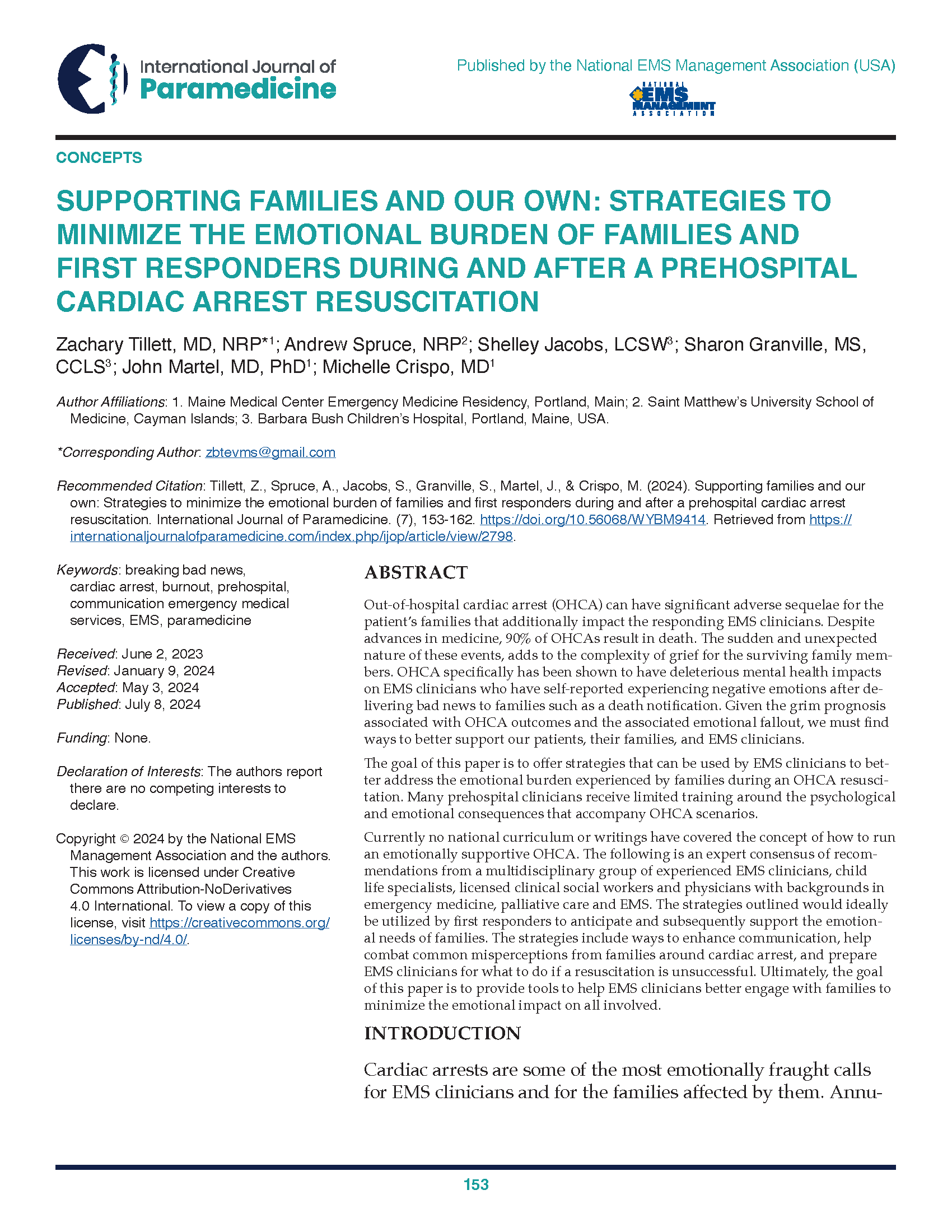Supporting Families and Our Own Strategies to Minimize the Emotional Burden of Families and First Responders During and After a Prehospital Cardiac Arrest Resuscitation
Main Article Content
Abstract
Out-of-hospital cardiac arrest (OHCA) can have significant adverse sequelae for both the patient’s families, as well as the responding EMS clinicians. Despite advances in medicine, 90% of OHCA result in death. The sudden and unexpected nature of these events, adds to the complexity of grief for the surviving family members. OHCA specifically has been shown to have deleterious mental health impacts on EMS clinicians who have self-reported experiencing negative emotions after delivering bad news to families such as a death notification. Given the grim prognosis associated with OHCA outcomes and associated emotional fallout, we must find ways to better support our patients, families, and EMS clinicians.
The goal of this paper is to offer recommendations and tools that can be used by EMS clinicians to better address the emotional burden experienced by families during an OHCA resuscitation. Many Pre-hospital clinicians receive limited training around the psychologic and emotional consequences that accompany OHCA scenarios.
Currently no national curriculum or writings that the authors are aware of have covered the concept of how to run an emotionally supportive OHCA. The following is an expert consensus of recommendations from a group of experienced EMS clinicians, a child life specialist, a licensed clinical social worker and physicians with backgrounds in emergency medicine, palliative care and EMS. The strategies outlined would ideally be utilized by first responders helping to anticipate and subsequently support the emotional needs of families. The strategies range from ways to enhance communication, help combat common misperceptions from families around cardiac arrest and prepare EMS clinicians for what to do if a resuscitation is unsuccessful. Ultimately the goal of this paper is to provide the tools to help EMS clinicians better align themselves with families to minimize the emotional impact on all involved.
Article Details

This work is licensed under a Creative Commons Attribution-NoDerivatives 4.0 International License.
Publishing in IJOP allows authors to keep their copyright while giving IJOP unrestricted copyright permissions. Articles published in IJOP use Creative Common Attribution 4.0 International (CC BY-ND 4.0) licensing. This license requires that re-users give credit to the creator. It allows re-users to copy and distribute the material in any medium or format in unadapted form only, even for commercial purposes. Additional terms apply and can be accessed here.
Publishing in IJOP also allows authors to have contracts for non-exclusive distribution of the Journal's published version of the article, such as posting to an institutional repository or publication in a book, on the condition that the original publication in the original layout format in IJOP is retained and acknowledged.
We permit and encourage authors to post the articles they published in IJOP on their affiliated websites. This helps share the information, encourages citation in other works, and promotes scholarly discourse in the spirit of open access.
References
Benjamin, E., Mutner, P., Alonso, A., et al. (2019). Heart disease and stroke statistics 2019 update. Circulation, 139, e56-e528. https://doi.org/10.1161/CIR.0000000000000659
De Stefano, C., Normand, D., Jabre, P., et al. (2016). Family Presence during Resuscitation: A Qualitative Analysis from a National Multicenter Randomized Clinical Trial. PLOS One, 11(6), e0156100. doi: 10.1371/journal.pone.0156100
Diem, S., Lantos, J., & Tulsky, J. (1996). Cardiopulmonary Resuscitation on Television. New England Journal of Medicine, 334, 1578-1582. https://doi.org/10.1056/NEJM199606133342406
Ellis, P., & Tattersall, M. (2009). How should doctors communicate the diagnosis of cancer to patients? Annals of Medicine, 31(5), 336-341. https://doi.org/10.3109/07853899908995900
Grunau, B., Kime, N., Leroux, B., et al. (2020). Association of Intra-arrest Transport vs Continued On-Scene Resuscitation With Survival to Hospital Discharge Among Patients With Out-of-Hospital Cardiac Arrest. JAMA, 324(11), 1058–1067. https://doi.org/10.1001/jama.2020.14185
Heyman, M., Dill, J., & Douglas, R. (2018). The Ruderman White Paper on Mental Health and Suicide of First Responders. Ruderman Family Foundation. Retrieved from https://rudermanfoundation.org/white_papers/police-officers-and-firefighters-are-more-likely-to-die-by-suicide-than-in-line-of-duty/
Jabre, P., Belpomme, V., Azoulay, E., et al. (2013). Family Presence During Cardiopulmonary Resuscitation. New England Journal of Medicine, 368, 1008-1018. https://www.nejm.org/doi/full/10.1056/NEJMoa1203366
Keyes, K., Pratt, C., Galea, S., McLaughlin, K., Koenen, K., & Shear, M. (2014). The burden of loss: unexpected death of a loved one and psychiatric disorders across the life course in a national study. American Journal of Psychiatry, 171(8), 864-871. https://doi.org/10.1176/appi.ajp.2014.13081132
Schonwetter, R., Teasdale, T., Taffet, G., Robinson, B., & Luchi, R. (1991). Educating the Elderly: A CPR Resuscitation Before and After Intervention. Journal of the American Geriatrics Society, 39, 372-377. https://doi.org/10.1111/j.1532-5415.1991.tb02902.x
Stewart, S. (2019). Parent’s Experience During A Child's Resuscitation: Getting Through It. Journal of Pediatric Nursing, 47, 58-67. https://doi.org/10.1016/j.pedn.2019.04.019
Tillett, Z., Jacobs, S., & Crispo, M. (2024). Breaking Bad News in the Prehospital Setting: A Guide for EMS Clinicians. International Journal of Paramedicine, (6), 163–170. https://doi.org/10.56068/GLAR2701
Tillett, Z., Martell, J., Crispo, M., & Strout, T. (2022). An Assessment of Out-of-Hospital Provider Education and Sequelae Around Breaking Bad News. Annals of Emergency Medicine, 80(4 Suppl), S43. https://doi.org/10.1016/j.annemergmed.2022.08.108
Vigil, N., Grant, A., Perez, O., et al. (2019). Death by Suicide-The EMS Profession Compared to the General Public. Prehospital Emergency Care, 23(3), 340-345. https://doi.org/10.1080/10903127.2018.1514090

